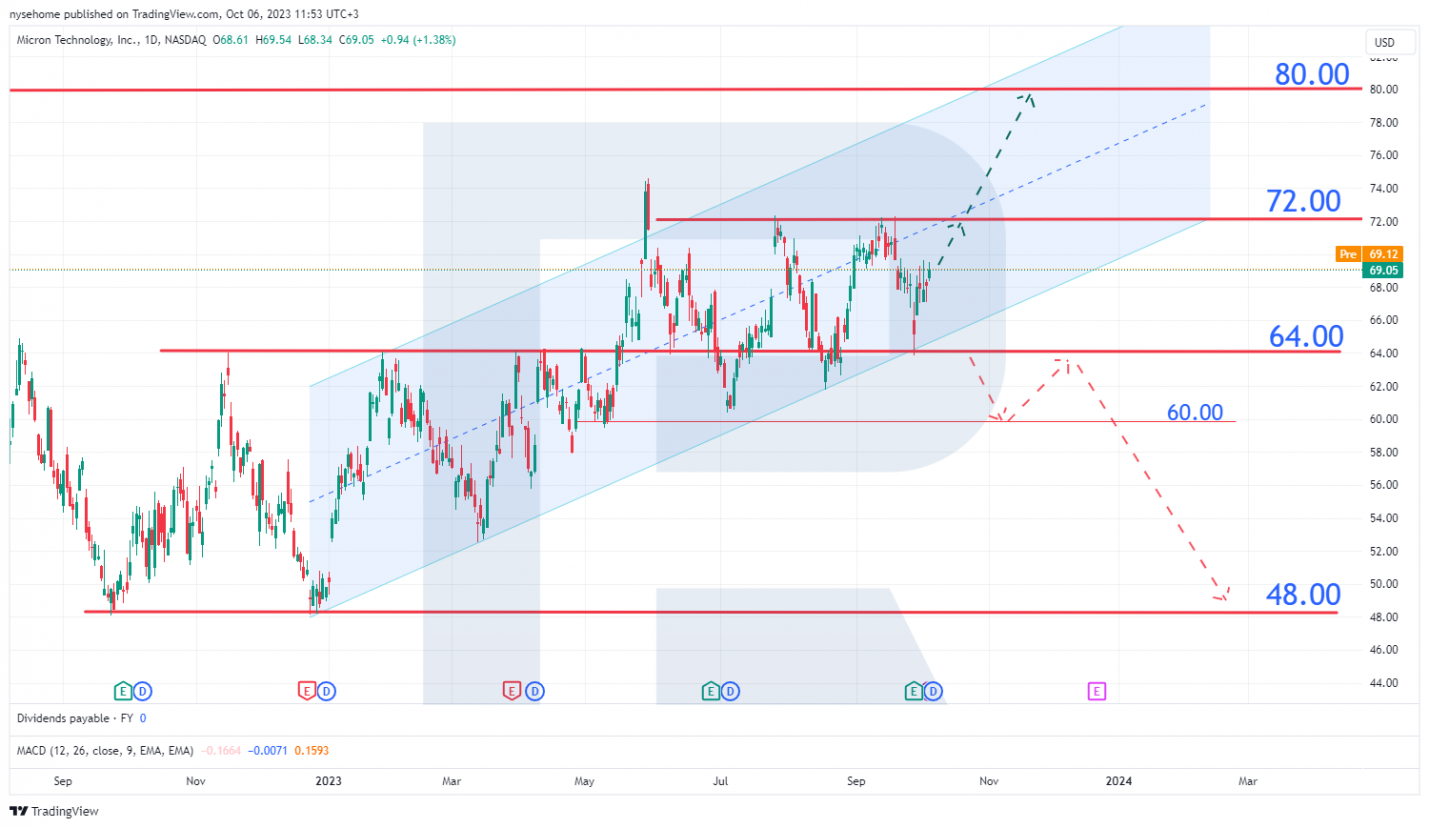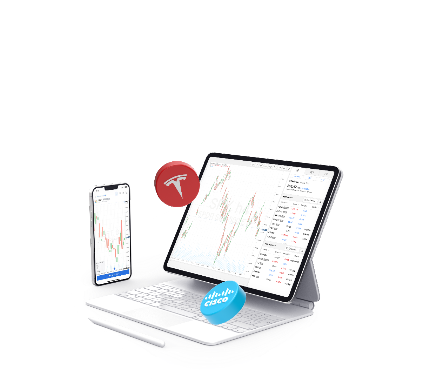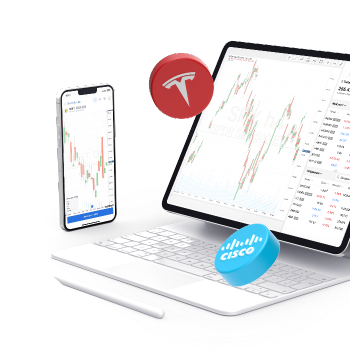Micron Technology Stock Analysis: Losses Decrease, and Shares Gradually Rise

7 minutes for reading
Micron Technology Inc (NASDAQ: MU) presented its financial report for Q4 fiscal 2023, posting losses of 1.43 billion USD. However, the company’s management confidently asserts that the most challenging times are in the past and predicts a recovery in demand within the semiconductor sector as customer inventories, which were previously accumulated, decrease. At the same time, Micron’s stock is on a gradual rise. In this article, we will examine Micron Technology’s quarterly earnings report and conduct a technical analysis of the company’s stock.
About Micron Technology Inc.
Micron Technology, a US company based in Boise, Idaho and founded in 1978, specialises in producing semiconductor devices. Its primary products include DRAM and NAND memory chips, flash memory, SSD storage media, and CMOS sensors.
Micron’s products are used in various sectors, including mobile devices, computer hardware, networking equipment, embedded systems, and data storage. In addition, the company invests in developing and producing advanced semiconductor technologies such as 3D XPoint, a new type of high-speed, high-capacity non-volatile memory. Micron collaborates with industry leaders like Intel Corp. (NASDAQ: INTC), International Business Machines Corp. (NYSE: IBM), and NVIDIA Corp (NASDAQ: NVDA) to create innovative solutions for cloud computing, artificial intelligence, and the internet of things.
Financial performance of Micron Technology
Micron Technology ended its financial report for Q4 2023 on 31 August 2023 and officially announced the results on 27 September 2023. The report's key highlights are as follows:
Revenue of Micron Technology for Q4 2023
Amount: 4.01 billion USD
Trends:
- Compared to the previous quarter: +7%
- Compared to the same period of 2022: -40%
Net loss of Micron Technology for Q4 2023
Amount: 1.43 billion USD
Trends:
- Compared to the last quarter: -25%
- Compared to the same period of 2022: -4%
Note: The company reduced its losses for the second consecutive quarter.
Quarterly revenue of the Mobile division
Earnings: 1.2 billion USD
Quarterly change: +48%
Annual change: -20%
Primary growth driver: increasing sales of DRAM and NAND for smartphones and tablets
Quarterly revenue of the Data Storage Systems Division
Earnings: 739 million USD
Quarterly change: +18%
Annual change: -17%
Primary growth driver: increased demand for SSD storage media for cloud services and data centres
Quarterly revenue of the Embedded Solutions Division
Earnings: 860 million USD
Quarterly change: -6%
Annual change: -34%
Primary decline driver: declining sales of memory chips for automotive and industrial electronics due to previously accumulated inventories
Quarterly revenue of the Computing and Networking Division
Earnings: 1.2 billion USD
Quarterly change: -14%
Annual change: -59%
Primary decline driver: decreasing demand for DRAM in the server and PC sectors
Statements from the company’s management
Sanjay Mehrotra, CEO of Micron, emphasised that the company sees signs of recovery in the memory sector, with supply and demand becoming more balanced and prices stabilising. He also highlighted Micron’s potential for growth in data processing and artificial intelligence segments thanks to the rising demand for high-performance, high-capacity memory chips.
Micron Technology’s forecasts
For the upcoming quarter ending on 31 November 2023, Micron forecasts a net loss of 1.07 USD per share (potentially fluctuating by 0.07 USD in either direction) and total revenue of 4.4 billion USD (potentially fluctuating by 200 million USD in either direction). This equates to 88 cents per share with revenue of 4.24 billion USD. Experts attribute the reduction in Micron’s losses to a conservative approach to the company’s offerings, a decrease in previously accumulated client inventories, and a recovery in demand.
Micron Technology’s competitors
Micron’s primary competitors on the global stage are South Korean giants Samsung (KRX: 005930) and SK Hynix (KRX: 000660), both of which lead in the production of DRAM and NAND flash memory chips. These companies have scale, technology, and economic efficiency advantages, making them serious rivals. It is worth noting that Samsung is particularly active in the smartphone market, where the company uses its own memory chips for its devices.
Micron’s competitor in the US is Western Digital Corp. (NASDAQ: WDC) with NXP Semiconductors N.V. (NASDAQ: NXPI) and STMicroelectronics N.V. (NYSE: STM) as its primary rivals in the European market. These two companies are the world’s leading suppliers of automotive semiconductors, providing memory chips for driver assistance systems (ADAS) and infotainment systems.
One of Micron’s advantages is its diversified portfolio of memory products, allowing the company to cater to various markets, including data centres, mobile devices, consumer electronics, industrial applications, and the automotive industry. In addition, Micron maintains strategic partnerships with leading technology companies such as Intel, Microsoft Corporation (NASDAQ: MSFT), Alphabet Inc (NASDAQ: GOOG), Nvidia, and Qualcomm, Inc. (NASDAQ: QCOM).
It is essential to highlight the competition from Samsung and SK Hynix, particularly given the strained relations between the US and China. These companies might seize the current situation to expand their presence in the Chinese market, potentially infringing on Micron’s share.
Impact of the trade war between the US and China
The trade war between the US and China continues. Apart from the US restrictions on investments in the technology sector and trade in crucially important semiconductors, China also introduced its bans, with one of them affecting Micron.
It was announced on 22 May that the Chinese government had imposed restrictions on Micron, banning the company from participating in key infrastructure projects. China is one of Micron’s primary target markets, accounting for nearly 10% of the company’s revenue.
Following the news release, Samsung and SK Hynix stocks were headed upwards as the restrictions did not impact these companies, and the US sanctions did not limit their operations either. As a result, Micron’s share in China may be replaced with South Korean companies.
Micron Technology Inc. live stock chart
Micron Technology Inc. stock analysis
Despite substantial losses in 2023, Micron’s stock has surged by 38% since the beginning of the year. The S&P 500 index recorded a 27% lower return during the same period. Micron’s shares are currently trading within an ascending channel. They have rebounded from the trend line after the release of the quarterly earnings report, signalling a sustained uptrend. If the 72 USD resistance level is breached, it could drive the quotes towards the channel line near 80 USD, potentially reaching a new annual high.

In a possible pessimistic scenario, the price could break the 64 USD support level, indicating the end of the uptrend and a potential drop to the annual low of 48 USD.
Summary
An abrupt surge in demand for semiconductor products was seen in 2021 and the first half of 2022, significantly affecting Micron’s profitability during that period. However, as clients built up their product inventories, the demand declined, reducing earnings for semiconductor companies. From Q4 2022 to date, Micron has encountered challenges in achieving profitability.
If the demand for semiconductors was at its peak in 2022, it could reach its lowest level in 2023, after which it might either resume growth or stabilise. As mentioned, Micron's management foresees that the decline in semiconductor demand has ended. This is a positive indicator for the company, as there is room for growth, primarily driven by the expansion of electric vehicles and advancements in AI. With this background, the company’s stock has the potential for long-term growth.
The situation could only deteriorate if a substantial interest rate increase triggers a US recession. In such a scenario, semiconductor demand might experience a further decline, leading to heightened losses for Micron.
* – Past performance is not a reliable indicator of future results or future performance.
The material presented and the information contained herein is for information purposes only and in no way should be considered as the provision of investment advice for the purposes of Investment Firms Law 87(I)/2017 of the Republic of Cyprus or any other form of personal advice or recommendation, which relates to certain types of transactions with certain types of financial instruments.


















 are complex instruments and come with a high
are complex instruments and come with a high  of losing
of losing  rapidly due to
rapidly due to  . 65.68% of retail investor accounts lose
. 65.68% of retail investor accounts lose  when trading
when trading  with this provider. You should consider whether you understand how CFDs work and whether you can afford to take the high
with this provider. You should consider whether you understand how CFDs work and whether you can afford to take the high